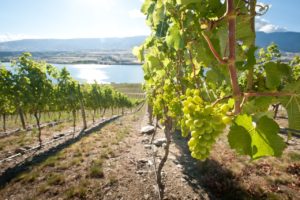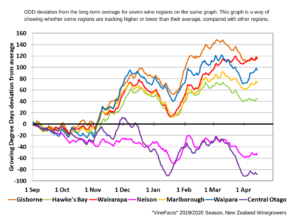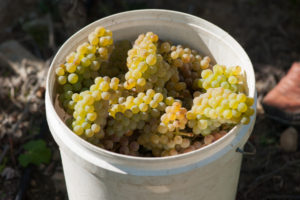
Following on an excellent growing season in 2019, the vineyard was poised for another great season with the vines having good carbohydrate reserves. One always starts a new season optimistic but fully aware that the weather may not co-operate. This season ended up being much more of a roller coaster than normal and we had the impact of the Covid-19 crisis at the start of harvest!
 The season started with October being on the dry side and relatively cold, but as always, our steep free-draining slopes saw most of the frost risk minimised. We started to irrigate a little earlier than normal to promote some early growth and build strength in the new shoots. In November temperatures started to increase but unfortunately the heat was accompanied by wind which continued to make its presence felt well into December. Spring winds give rise to multiple challenges in the vineyard both in terms of applying sprays in a timely and effective way, and also when trying to train the vines safely upwards. Work on the vines ends up being repeated to avoid damage to the leaves and young growing tips.
The season started with October being on the dry side and relatively cold, but as always, our steep free-draining slopes saw most of the frost risk minimised. We started to irrigate a little earlier than normal to promote some early growth and build strength in the new shoots. In November temperatures started to increase but unfortunately the heat was accompanied by wind which continued to make its presence felt well into December. Spring winds give rise to multiple challenges in the vineyard both in terms of applying sprays in a timely and effective way, and also when trying to train the vines safely upwards. Work on the vines ends up being repeated to avoid damage to the leaves and young growing tips.
In January, although things started off a little cool, the temperatures finally increased, and we had some real warmth through into February which was above average in terms of heat summation (GDDs were 7% above average). Interestingly whilst we still had the typical Central Otago mid-summer heat, the peak temperatures were still more moderate than we often see with the maximum February temperature in Cromwell being 29.7 deg C, so the heat was more useful than more extreme high temperatures when the vines stop functioning.
By the time we reached March it felt like we were deep into Autumn temperatures with the month ending as one of our coolest on record. Also, the Covid-19 pandemic made an impact across New Zealand and the country entered complete lockdown on the 26th March. Given our cooler season, in fact the coldest since planting the vineyard in 2004, our picking started later than normal commencing on the 4th April. Picking grapes whilst watching snow fall on the Pisa range opposite, certainly reminded us of our high-altitude location.

Achieving sugar ripeness with lower yields was relatively easy and the cooler temperatures saw higher acidity retained. Picking decisions have been challenging as it was more a matter of waiting for acids to drop, flavours to develop and avoiding berry shrivel particularly in the Pinot Noir where the smaller berries can be fragile. Despite the somewhat trying growing conditions, the overall fruit condition was very good which will ensure brightness of flavours.
It’s early days in the ferments but generally smaller berries in Pinot Noir mean good flavour intensity, colour and tannin. Gewürztraminer was a casualty of the season with very small volumes and hence our decision to only make our dry style “The Gallery” this vintage and to instead produce a late-harvest style from the more traditional Riesling variety for the first time.

Fortunately, the wine industry, as a primary producer, was classified an ‘essential business’ and has been able to undertake harvest and make wine. The Ministry for Primary Industries (MPI) have been present throughout the country for the harvest confirming the industry’s ability to operate in a safe manner from a public health point-of-view. Operations in the vineyard and winery have been carried out under the strict protocols and it has required modifications to all activities in order to maintain appropriate staff separation as all of our harvest (which is all done by hand), has been carried out during the lockdown. But beyond everything taking a bit longer and requiring a bit more thought, the harvest has gone very well.
